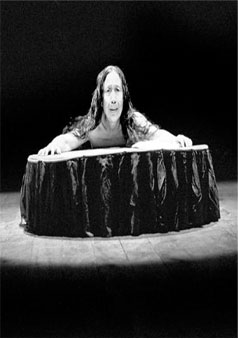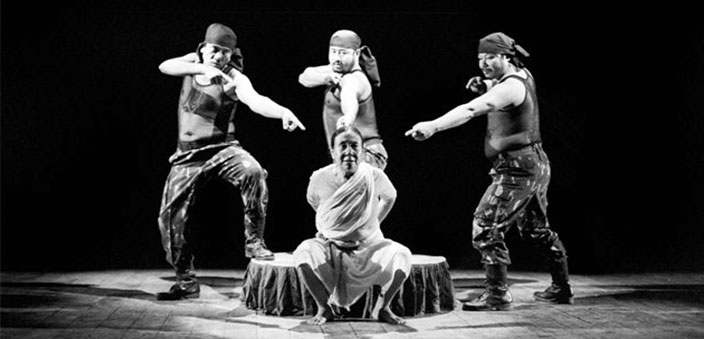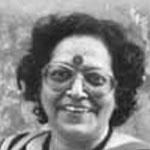Translating, interpreting, re-reading, questioning and critiquing literature from the printed word into the world of the proscenium theatre, is truly a daunting task. It becomes a veritable challenge specially when one decides to dramatise the works of Mahasweta Devi that seem to be extremely difficult to bring to the stage considering that they occupy a world that is distant from the direct experience of the people who stage the play, who are urban and modern, sophisticated intellectuals. Few of Mahasweta Devi’s works have been turned into stage plays. This article revolves around two of her most famous short stories, Draupadi and Rudali.
Draupadi
In her short story Draupadi (which first appeared in Agni Garbha (Womb of Fires, a collection of loosely connected short narratives) Mahasweta Devi rewrote an episode from the great epic Mahabharata, and as a feminist response to the myth of Draupadi (the icon of womanhood in Hindu mythology), re-invented cultural history that deconstructs the representation of women, cultures, images, stereotypes and archetypes. The politics of interpretation has most often been the politics of gender.

No one ever made a film based on Dopdi Mejhen of the story Draupadi. But it was made into a play and a brilliant play, that ought to be archived in the history of Indian theatre. Draupadi was directed by Heisnam Kanhaiyalal, and enacted by Sabitri Heissman from Kalakshetra, Manipur. Draupadi, or Dopdi as her name appears in dialect, is a rebel, hunted down by the government in their attempt to subjugate these groups. The government uses all forces available to them, including kidnapping, murder, and rape, and any tribal deaths in custody are invariably ‘accidents’. But Dopdi is not easily cowed. After continuous days of rape and abuse, deprived of food and water, the story ends with a magnificent finale in which she faces her abusers, naked and bloody, but fiercely strong.
Kalakshetra Manipur, is an Indian theatre group situated in Manipur. It was established in 1969 with Heissnam Kanhailal as founder director. Sabitri Heissman is his wife. Besides Draupadi, the group has been performing very unconventional works across the board such as Khsudita Pashan (Hungry Stones) based on a Tagore short story and Lajja based on Taslima Nasreen’s radical novel.
Draupadi is included in the collection Breast Stories (Seagull Books) translated and researched brilliantly by Gayatri Chakravorty-Spivak. “Mahasweta’s fiction aims at inverting such hegemonic, over-privileged, ever-signifying system of relationships, and attempts to bring low what were high, through the strategies of subversion and reversal. Her stories come across as the post-colonial, subaltern, gendered responses that serve to topsy-turvy such hierarchical structures, generating aesthetics of opposition in the process,” writes Vandana Beniwal Anup (2007), in her thesis Aesthetics of Activism: A Study of Mahasweta Devi’s Fiction.
Kalakshetra Manipur first staged Draupadi in 2000 followed by many performances across India and abroad. Sabitri Heissman Kanhaiyalal as Draupadi, uses her body on the stage both as text and and context. She topples the rape script completely by disrobing and standing naked in front of her rapists, rubbing her body against them filling, them with terror and fear they had earlier instilled in her, but which she triumphs over in her own way. It is a classic instance of an actress disrobing completely on a public platform. The meaning and purpose of the disrobing undercuts any sensual suggestions like it does in the story. Sabitri mesmerises her audience, holding them in thrall, speechless at her powerful expression of revolt against patriarchal, administrative and political forces. Sabitri transforms the proscenium space into a space of rebellion against the violation of human rights, in which a personal action mutates to become a strong political statement. Mahasweta Devi’s Draupadi is an attempt to deconstruct and reconstruct the episode of “Draupadi’s Cheerharan by Duryodhan”, from the great epic Mahabharata.
Rudali
Usha Ganguly’s Rangakarmee, that has spanned four decades of Hindi theatre in Kolkata and beyond had staged Rudali in Hindi the first time in 1992. Ganguly used a lot of black and when asked to perform extracts from the play, she would perform solo, putting her heart, soul, body and loud voice entirely into the act for the audience to sit up and take notice. Perhaps for the first time, Mahasweta introduces the urban reader to the world of professional mourners, women from the lowest cultural and economic hierarchy who are called when a male member of an affluent family dies, and is paid for crying loudly to express grief over the death.

Rudali is a powerful short story. Revolving around the life of Sanichari, a poor low caste village woman, it is an acidly ironic tale of exploitation and struggle, and survival. In 1992 it was adapted into a play by Ganguly, a leading theatre director of Kolkata, and instantly became one of the most acclaimed productions of its time. In both incarnations of Rudali – the text and the play, it is a woman who has constructed and deconstructed the text, and each version can be read and seen as an important feminist text in contemporary India. The text also leaves it open to different interpretations, liberating the context from its purely feminist message. The men in the story are no less victims of their caste, class and social status than women.
Sanichari, a woman from a small tribal pocket lives with her mother-in-law, her son, her daughter-in-law and grandson Budhua. Her mother Bhikni has left her with another man when she was very small. Sanichari belongs to a group of professional mourners who are called to cry loudly and beat their breasts when someone big, powerful and rich dies in the neighbourhood villages. This powerful story covers so many important topics. From abject poverty to the caste system and Indian funeral practices, as well as the role of women in a strongly patriarchal society, this story challenges readers on their ideas on poverty and feminism. A time comes when she cannot shed a single tear, nor can she beat her chest in fake grief, the money for which determines where her next meal will come from. She draws upon her inner sources of ceaseless grief and lets out a loud, heat-rending cry.
Rangakarmee’s Rudali ran to packed houses for several years, appreciated equally by critics and audiences. Both the novelette and the play, in performance, have been created by women auteur in command over their medium, their language of expression and their art – literature and theatre respectively. This has brought about two completely different texts with one feature in common – they offer a feminist, a sociological and a Marxist reading of each text.
Said Usha Ganguly: “I feel that I differ from the way people tend to use the term feminism. This term has nowadays become a fashionable one, and I don’t believe in a particular brand of feminism. Therefore I don’t want the play (Rudali) to be labelled as feminist. On the other hand, I believe in the liberation of women and their freedom, and I’m trying my best as a person, as a teacher and as a theatre worker, to work towards that.”
In a detailed article in Seagull Theatre Quarterly, Issue 1 (The Metamorphosis of Rudali), she said: “Sanichari and Bikhni don’t appeal to me simply because they belong to a different class. There is something very human in them, and that breaks the class barrier. Everybody is able to communicate with them, their struggle becomes everybody’s struggle … I strongly believe that Rudali is a women’s text. I believe that the Indian woman, whether it’s Sanichari or someone from the middle or upper class, is highly exploited in our society. Somehow in Rudali, I see Sanichari protesting against society as a whole. Somebody told me that Rudali is a play about a village. I don’t agree. It is not about a particular village or a city or even about a particular character, but about all of us: Sanichari represents women in general. It is the humanistic element that makes it acceptable to all of us”… But Mahasweta Devi, who wrote the story, firmly rejected the idea that her text could be exclusively identified with women because she believed that “gender is subsumed into the discourse of class.”


